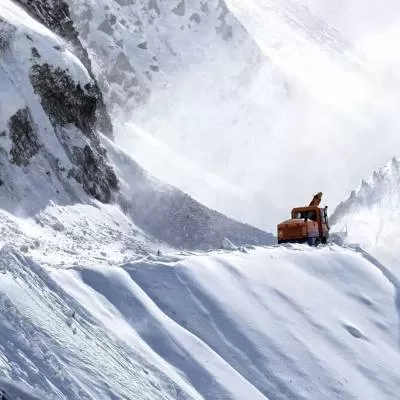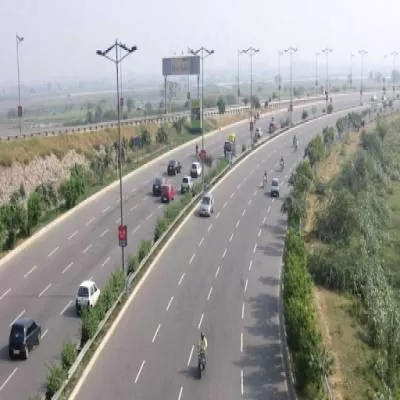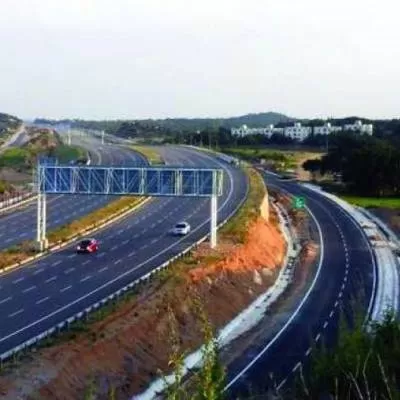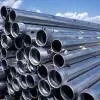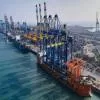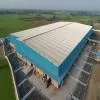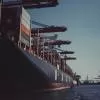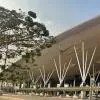- Home
- Infrastructure Transport
- ROADS & HIGHWAYS
- Connecting Pathways
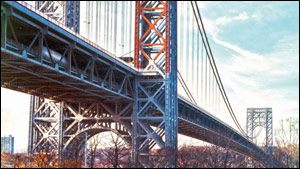
Connecting Pathways
How it works
The concept of floating bridges works on the natural law of buoyancy of water that supports the entire bridge by eliminating conventional foundation and substructure. The vertical load is resisted by buoyancy and the movement of the bridge, as well as the loads in longitudinal and transverse directions is arrested by anchoring arrangements (mooring).
The making
Floating bridges can be constructed with steel, concrete, wood, synthetic or a combination of these materials based on design requirements. Generally, reinforced concrete pontoons that have a post-tensioning arrangement with or without an elevated superstructure are preferred. The concrete used for this construction should be watertight to avoid corrosion of reinforcement. For this purpose, high-performance concrete consisting of fly ash or silica fumes is required to provide high strength and low permeability.
A pontoon made of concrete boxes is constructed at the shore according to the design requirement with different dimensions and wall thicknesses. The external walls are usually thicker than the internal ones to resist water pressure. The internal walls provide flexural stiffness to the pontoon and reduce bending moment and shear forces. They are floated and towed to the required location and connected to each other. The structure is anchored in a specific position with the help of a suitable mooring system that holds it in place. A roadway or superstructure is built over these pontoons to create the bridge.
A mooring system is one of the important elements in a floating bridge that should be well-designed to keep the bridge in a balanced position in all critical conditions. This system prevents the bridge from drifting owing to wind and wave forces. Some commonly used mooring systems include the dolphin guide frame system, cable or chain anchor, tension leg method, pier or quay wall method, and sliding piles.
Vital factors
Generally, floating bridges create hindarance the passage of vessels.
If the water body is meant for navigation, navigational openings need to be provided while designing the floating bridge for safe passage of boats and vessels. Alternatively, movable spans can be provided for this purpose. At the end of the floating bridges, an access bridge with abutments is also required to take care of the tidal variation and reduce undesirable forces.
The wave force tends to twist the bridge and leads to a fatigue on the materials owing to its recurrence loading. As this affects the service life of the bridge, control measures should be taken while planning it. Water leakage in the pontoon is also a matter of concern, for which measures should be taken to check and prevent the same.
Making the choice
Floating bridges are preferred under the following situations:
- If the water depth is too much, making it impossible to construct a fixed foundation.
- If the sea or riverbed is very weak, making it impracticable to rest the foundation.
- If the bridge location is in a remote place where in-situ construction is not feasible.
- If there is restriction at the bridge location because of environmental and biological constraints to make a conventional bridge.
- If the water body is subjected to high tidal variation, making it impossible to carry out any construction work.
- If the bridge location is situated in high seismic zones where there are possibilities of disruption to the foundation.
- If the bridge is to be constructed in a short period of time, especially in case of an emergency or military operation.
- If the bridge is to be used for a temporary and short duration.
Design valuations
The precise value of wave forces and wind forces is to be considered and the structure designed as a typical beam on an elastic foundation method. The horizontal forces acting on the pontoons owing to waves, wind and water current are much higher.
This influences the structures and its connections along with the mooring system. In the case of framed structures, horizontal forces produce greater bending.
The construction method and erection methodology play an important role in designing these structures. The size of the floating structure and the mooring system are determined based on the function and environmental conditions. The bridge should have adequate capacity to sustain the damages caused by collision of vessels, flooding and failure of mooring arrangement. In the case of a pre-tensioned mooring system, additional buoyancy is required to ensure the effects of pre-tension.
Dynamic loads are created on the structures owing to wave forces that can result in collapse. Hydrodynamic effects are created on the structure because of incident waves leading to motions like heave, swing and roll. According to the longitudinal bending stiffness of the pontoon and its connection type, the behaviour type such as rigid body, flexure elastic body, multi rigid body and multi flexure elastic body, is selected.
The pontoons of a floating bridge are generally designed for a period of 100 years, during which, minimum maintenance is required while the bridge is in operation. For this purpose, an efficient corrosion protection system should be engaged especially in the case of a marine environment. It is also necessary to provide a system for monitoring, inspection and maintenance during the service period.
Types of floating bridges
Depending on the construction process, there are two types of floating bridges: the continuous pontoon and the separate pontoon bridge.
- Continuous pontoon bridge: It is built with a number of concrete or steel hollow boxes that are connected to each other continuously to create a bridge. The width and length of the pontoon are determined by traffic requirements on the bridge.
- The bridge offers higher stability in terms of rolling and heave. Owing to its constant contact with water and structural continuity, the influence of the sea waves is high. The influence of wind is limited because of the compressive force on one side and suction force on the other.
- The forces of the mooring system are distributed along the entire length of the bridge.
- Separate pontoon bridge: It is built with individual pontoons that are spaced at required intervals and connected by girders. The differential vertical displacement in this type of bridge is solved by providing flexible connections. In most cases, this type of bridge construction requires a floating crane to erect the girders over the pontoons, thereby increasing construction cost. If the construction for this type of bridge is carried out with sufficient clearance for marine traffic, there will be no obstacle. As more than 50 per cent of the water surface is open to sea waves, the influence of these waves are less. Owing to the large contact area of the bridge, the influence of wind is higher. The forces of the mooring system are also distributed within a limited area of the pontoon. Further, according to functionality, there are two types of floating structures: semi-submersible and pontoon.
- Semi-submersible: A major portion of the structure is submerged in water and only the top portion is raised above sea level. This type is generally used in high seas with large waves.
- Pontoon: This type of structure comprises box sections that float on sea level. It is generally used in calm water or in water bodies with fewer waves.
- In India, bridges of this nature can be relevant for temporary use in remote areas where it is difficult to construct normal bridges due to shortage of capital. The Pontoon bridge at Majnu ka Tilla near Wazirabad in New Delhi is one such example in the country. The cost of a floating bridge is cheaper as compared to a concrete bridge as it does not require the construction of a foundation unlike other bridges. Its cost also varies depending upon the amount of traffic that the bridge will hold.
Major floating bridges in the world
- Hood Canal Bridge in the US; 2,398 m.
- Evergreen Point floating bridge across Lake Washington in the US; 2,310 m.
- Lacey V Murrow Memorial Bridge across Lake Washington in the US; 2,018 m.
- Demerara Harbour Bridge across river Demerara in Guyana; 1,851 m.
- Third Lake Washington Bridge across Lake Washington in the US; 1,771 m.
About the author:
BASIL MANOJ, Manager (Civil), L&T metro rail, Hyderabad, has 18 years of experience in the construction and supervision of major bridges, flyovers and urban viaducts constructed with innovative design and advanced construction technology.
Floating bridges are usually constructed to cross large water bodies that have huge depths or soft soil. They are built where the conventional foundation and substructure are not feasible. These types of bridges form major transportation links across diverse locations. In a conventional bridge,the structural elements of the foundation are expensive and require considerable time for construction. However, in the case of floating bridges, the foundation is absent, which saves in cost and time, thereby providing a cost-effective solution. How it works The concept of floating bridges works on the natural law of buoyancy of water that supports the entire bridge by eliminating conventional foundation and substructure. The vertical load is resisted by buoyancy and the movement of the bridge, as well as the loads in longitudinal and transverse directions is arrested by anchoring arrangements (mooring). The making Floating bridges can be constructed with steel, concrete, wood, synthetic or a combination of these materials based on design requirements. Generally, reinforced concrete pontoons that have a post-tensioning arrangement with or without an elevated superstructure are preferred. The concrete used for this construction should be watertight to avoid corrosion of reinforcement. For this purpose, high-performance concrete consisting of fly ash or silica fumes is required to provide high strength and low permeability. A pontoon made of concrete boxes is constructed at the shore according to the design requirement with different dimensions and wall thicknesses. The external walls are usually thicker than the internal ones to resist water pressure. The internal walls provide flexural stiffness to the pontoon and reduce bending moment and shear forces. They are floated and towed to the required location and connected to each other. The structure is anchored in a specific position with the help of a suitable mooring system that holds it in place. A roadway or superstructure is built over these pontoons to create the bridge. A mooring system is one of the important elements in a floating bridge that should be well-designed to keep the bridge in a balanced position in all critical conditions. This system prevents the bridge from drifting owing to wind and wave forces. Some commonly used mooring systems include the dolphin guide frame system, cable or chain anchor, tension leg method, pier or quay wall method, and sliding piles. Vital factors Generally, floating bridges create hindarance the passage of vessels. If the water body is meant for navigation, navigational openings need to be provided while designing the floating bridge for safe passage of boats and vessels. Alternatively, movable spans can be provided for this purpose. At the end of the floating bridges, an access bridge with abutments is also required to take care of the tidal variation and reduce undesirable forces. The wave force tends to twist the bridge and leads to a fatigue on the materials owing to its recurrence loading. As this affects the service life of the bridge, control measures should be taken while planning it. Water leakage in the pontoon is also a matter of concern, for which measures should be taken to check and prevent the same. Making the choice Floating bridges are preferred under the following situations: If the water depth is too much, making it impossible to construct a fixed foundation. If the sea or riverbed is very weak, making it impracticable to rest the foundation. If the bridge location is in a remote place where in-situ construction is not feasible. If there is restriction at the bridge location because of environmental and biological constraints to make a conventional bridge. If the water body is subjected to high tidal variation, making it impossible to carry out any construction work. If the bridge location is situated in high seismic zones where there are possibilities of disruption to the foundation. If the bridge is to be constructed in a short period of time, especially in case of an emergency or military operation. If the bridge is to be used for a temporary and short duration. Design valuations The precise value of wave forces and wind forces is to be considered and the structure designed as a typical beam on an elastic foundation method. The horizontal forces acting on the pontoons owing to waves, wind and water current are much higher. This influences the structures and its connections along with the mooring system. In the case of framed structures, horizontal forces produce greater bending. The construction method and erection methodology play an important role in designing these structures. The size of the floating structure and the mooring system are determined based on the function and environmental conditions. The bridge should have adequate capacity to sustain the damages caused by collision of vessels, flooding and failure of mooring arrangement. In the case of a pre-tensioned mooring system, additional buoyancy is required to ensure the effects of pre-tension. Dynamic loads are created on the structures owing to wave forces that can result in collapse. Hydrodynamic effects are created on the structure because of incident waves leading to motions like heave, swing and roll. According to the longitudinal bending stiffness of the pontoon and its connection type, the behaviour type such as rigid body, flexure elastic body, multi rigid body and multi flexure elastic body, is selected. The pontoons of a floating bridge are generally designed for a period of 100 years, during which, minimum maintenance is required while the bridge is in operation. For this purpose, an efficient corrosion protection system should be engaged especially in the case of a marine environment. It is also necessary to provide a system for monitoring, inspection and maintenance during the service period. Types of floating bridges Depending on the construction process, there are two types of floating bridges: the continuous pontoon and the separate pontoon bridge. Continuous pontoon bridge: It is built with a number of concrete or steel hollow boxes that are connected to each other continuously to create a bridge. The width and length of the pontoon are determined by traffic requirements on the bridge. The bridge offers higher stability in terms of rolling and heave. Owing to its constant contact with water and structural continuity, the influence of the sea waves is high. The influence of wind is limited because of the compressive force on one side and suction force on the other. The forces of the mooring system are distributed along the entire length of the bridge. Separate pontoon bridge: It is built with individual pontoons that are spaced at required intervals and connected by girders. The differential vertical displacement in this type of bridge is solved by providing flexible connections. In most cases, this type of bridge construction requires a floating crane to erect the girders over the pontoons, thereby increasing construction cost. If the construction for this type of bridge is carried out with sufficient clearance for marine traffic, there will be no obstacle. As more than 50 per cent of the water surface is open to sea waves, the influence of these waves are less. Owing to the large contact area of the bridge, the influence of wind is higher. The forces of the mooring system are also distributed within a limited area of the pontoon. Further, according to functionality, there are two types of floating structures: semi-submersible and pontoon. Semi-submersible: A major portion of the structure is submerged in water and only the top portion is raised above sea level. This type is generally used in high seas with large waves. Pontoon: This type of structure comprises box sections that float on sea level. It is generally used in calm water or in water bodies with fewer waves. In India, bridges of this nature can be relevant for temporary use in remote areas where it is difficult to construct normal bridges due to shortage of capital. The Pontoon bridge at Majnu ka Tilla near Wazirabad in New Delhi is one such example in the country. The cost of a floating bridge is cheaper as compared to a concrete bridge as it does not require the construction of a foundation unlike other bridges. Its cost also varies depending upon the amount of traffic that the bridge will hold. Major floating bridges in the world Hood Canal Bridge in the US; 2,398 m. Evergreen Point floating bridge across Lake Washington in the US; 2,310 m. Lacey V Murrow Memorial Bridge across Lake Washington in the US; 2,018 m. Demerara Harbour Bridge across river Demerara in Guyana; 1,851 m. Third Lake Washington Bridge across Lake Washington in the US; 1,771 m. About the author: BASIL MANOJ, Manager (Civil), L&T metro rail, Hyderabad, has 18 years of experience in the construction and supervision of major bridges, flyovers and urban viaducts constructed with innovative design and advanced construction technology.


